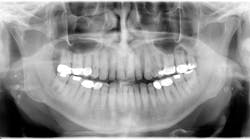Tonsil stones: A comprehensive overview
The tonsils are an integral part of the lymphatic system. They help trap and filter out bacteria that enter the body through the mouth and nose. While the connection between tonsillar microorganisms and distant organ diseases requires further investigation, the role of these microorganisms in tonsil stone formation is well-established.1,2
Tonsil stones, also known as tonsilloliths, are calcified concretions that form within the tonsillar crypts. While generally benign, they can cause discomfort and halitosis. The formation of tonsil stones is a multifactorial process involving the entrapment of debris (bacteria, food particles, desquamated epithelial cells, and mucus) in the tonsillar crypts.
Its etiopathogenesis begins with debris accumulation. The bacteria present in the crypts metabolize organic matter, producing volatile sulfur compounds (VSCs) that contribute to halitosis. Over time, this debris undergoes calcification, forming the hard, calcareous deposits characteristic of tonsil stones.3
Tonsil stones are more frequently observed in adults between their second and fourth decades. Although they can occur in children, they’re less common due to the small size and shallow depth of children’s tonsillar crypts.
Clinical aspects and signs and symptoms
Tonsil stones can vary from tiny specks to large masses, typically white/yellow in color and with an irregular shape. They’re often asymptomatic and discovered incidentally during a routine oral exam. However, when symptoms do occur, they may include halitosis,4 sore throat, difficulty swallowing, and ear pain (due to shared nerve pathways).
Tonsil stones are straightforward to diagnose. A visual exam, often aided by a tongue depressor, can reveal the presence of these calcifications in the tonsillar crypts.5
Treatment for tonsil stones varies based on their size and whether they cause symptoms. Small stones that don't cause problems often don't need treatment and may dislodge naturally. However, if the stones cause symptoms, a health-care professional might need to remove them manually. Lastly, a tonsillectomy may be the treatment of choice for these large or recurring stones.
The TikTok factor
An article by Bharat et al. explores the possible link between the increasing popularity of tonsil stone removal videos on TikTok and the rising rates of tonsillectomies.6 The authors found that between 2016 and 2021, there was a significant increase in patients seeking medical attention for tonsil stones and tonsillectomies. This trend coincided with the growing popularity of videos showcasing tonsil stone removal and home remedies.
While the study doesn't prove causation, it suggests that TikTok may influence patient behavior and decisions regarding tonsil stone treatment. The easy access to information and often graphic visualizations on TikTok may make individuals more aware of them; they may seek treatment and may even resort to unsafe DIY removal.7
The good, the bad, and the ugly
On the positive side, TikTok videos can educate people about tonsil stones, showing they’re a common issue and providing helpful visuals of professional removal procedures. Some creators even offer tips on oral hygiene and gargling to prevent stones from forming.
However, there are downsides. Misinformation can spread easily, with some videos promoting unsafe or ineffective DIY removal methods. Many videos even depict individuals removing their stones with tools, which can be risky and lead to complications such as infection, bleeding, gagging, and choking. Additionally, some videos exaggerate the size or severity of tonsil stones for shock value, causing people unnecessary anxiety.
Now that we know this, what’s our role?
While good oral hygiene can minimize the risk of tonsil stones, it’s equally crucial to educate patients about the hazards of DIY removal methods.
Tonsil stones may seem like they can be fixed easily, but attempting to remove them at home can lead to many complications. Improper techniques can introduce bacteria, causing infections, bleeding, and scarring from sharp tools or excessive force. In some cases, aggressive poking can even damage the surrounding areas, leading to further discomfort.
By promoting professional intervention, we can ensure that tonsil stones are managed safely and effectively. Dentists and ENTs have the expertise and tools to remove them without causing harm and can provide guidance on preventing future occurrences while addressing any concerns.
1. Choi DH, Park J, Choi JK et al. Association between the microbiomes of tonsil and saliva samples isolated from pediatric patients subjected to tonsillectomy for the treatment of tonsillar hyperplasia. Experiment molecular med. 2020;52(9):1564-1573.
2. Bella Z, Erdélyi E, Kiricsi Á, et al. Comparative evaluation of culture results and composition of microbiome of removed tonsils due to distant focal disease or other reasons. A prospective pilot study. Acta microbiologica et immunologica Hungarica. 2024;71(2):182-189. doi:10.1556/030.2024.02279
3. Shikino K, Ikusaka M. Tonsillolith. Clinical case reports. Wiley Online Library. 2021;9(6):e04243. doi:10.1002/ccr3.4243
4. Ferguson M, Aydin M, Mickel J. Halitosis and the tonsils: a review of management. Otolaryngol Head Neck Surg. 2014;151(4):567-574. doi:10.1177/0194599814544881
5. Babu BB, Tejasvi MLA, Avinash CK, Tonsillolith: a panoramic radiograph presentation. J Clin Diagn Res. 2013;7(10):2378-2379. doi:10.7860/JCDR/2013/5613.3530
6. Bharat N, Sandelski M, Cerasiello S, Hurtuk A. TikTok influence on rates of tonsillectomies for tonsil stones. Cureus. 2023;15(4):e37957. doi:10.7759/cureus.37957
7. Sulibhavi A, Isaacson G. TikTok tonsils. Ear, Nose, Throat J. 2024;103(3):NP183–NP184. doi:10.1177/01455613211038340
About the Author

Andreina Sucre, MSc, RDH
Andreina Sucre, MSc, RDH, is an international dentist, oral pathology, and oral surgery specialist practicing dental hygiene in Miami, Florida. A passionate advocate for early pathological diagnosis, she empowers colleagues through lectures focused on oral pathologies. Andreina spoke on this topic at the 2024 ADHA Annual Conference, 2023 RDH Under One Roof, and she writes about oral pathology for RDH magazine. Committed to community outreach, she educates non-native English-speaking children on oral health and actively volunteers in dental initiatives.




